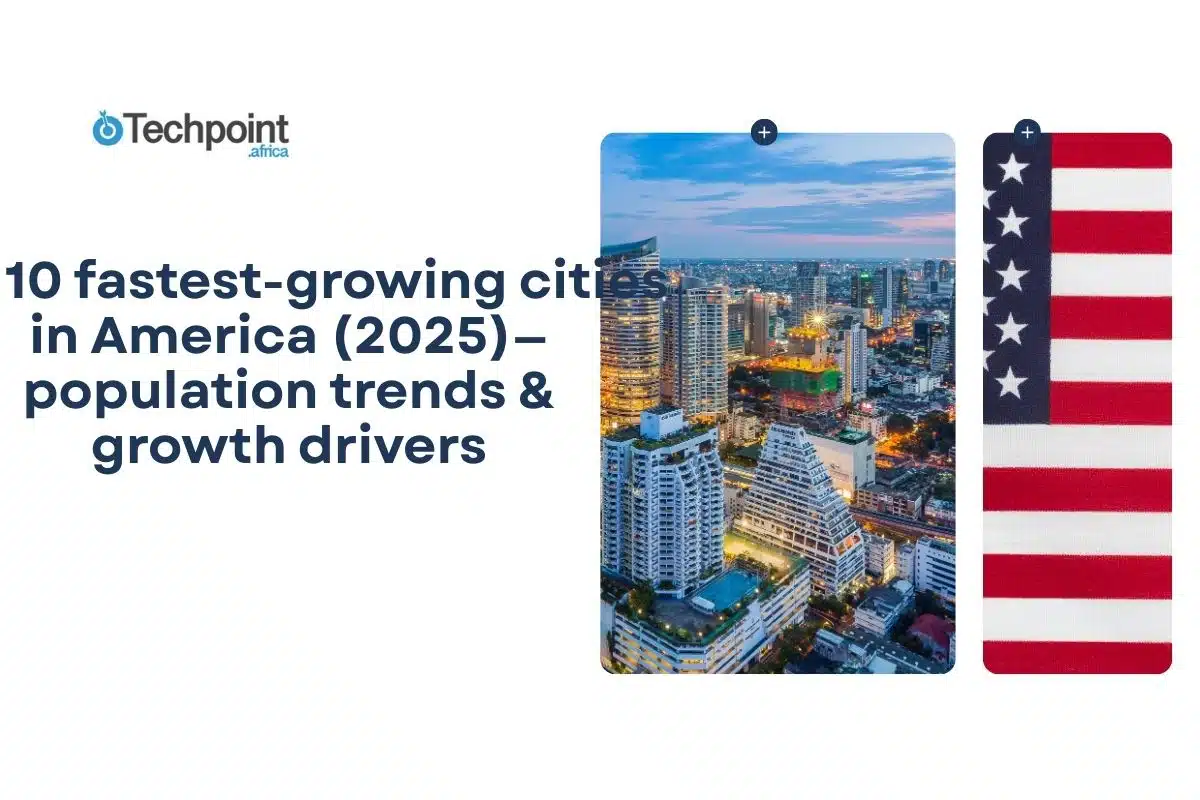When I wrote about the fastest-growing cities in the world, one fact that stood out was that no American city made the list. Instead, it was dominated by cities in Africa and Asia, regions where youthful populations, infrastructural development, and shifting economic landscapes are reshaping the urban future. This fact spurred a critical question. While the regions mentioned above are expanding, what are the 10 fastest-growing cities in America in 2025, and why?
With the global population now over 8 billion, the United Nations projects it will peak at around 10.3 billion by the mid-2080s. While India, China, and Nigeria are expected to account for 35% of the world’s urban population growth between 2018 and 2050, the United States of America witnessed a 0.52% population increase from 2024, rising to 343,603,404 in 2025, making it the third most populous country, according to Worldometer.
While the global population is growing, it’s not evenly distributed. Birth rates, death rates, and migration patterns define this imbalance. Some cities continue to grow, positioning themselves at the forefront of migration, investment, and development, while others struggle to keep pace.
Amid this, there is a concern that many rapidly expanding cities lack the infrastructure to support their growth. This article highlights the 10 fastest-growing cities in America, examining what drives their growth and why it matters for individuals considering investment, relocation, or market entry.
Just like the other time, here’s a little secret and a fun fact: 10 out of the top 12 fastest-growing cities in America are within a state. Surprising, right? Continue reading to figure out the state and more exciting discoveries.
Key Takeaways
- Texas dominates the list with 9 out of the top 10 fastest-growing cities in America.
- This growth creates pressure on infrastructure, leading cities to invest in roads, schools, and utilities.
- Several positive steps have been taken by key stakeholders, especially policymakers, but these efforts must accelerate as the cities continue to grow.
- The United States of America witnessed a 0.52% population increase from 2024, rising to 343,603,404 in 2025, making it the third most populous country.
Major factors behind the rapid growth of cities in 2025
Fast-growing cities are urban areas experiencing significant population growth, driven by migration, economic opportunities, and improved living standards. This growth often results from a combination of natural population growth and rural-to-urban migration, fueled by access to jobs, education, and healthcare.
- Natural population increase occurs when urban areas experience higher birth rates and lower death rates compared to rural areas.
- Economic and technological development: A city grows when there is economic growth, industrialization, and technological advancements, which create jobs, attract investment, and improve infrastructure.
- Improved infrastructure: A city also grows when there is improved transportation, communication, and utilities. This makes it attractive and efficient, leading to increased settlement and economic activity.
10 fastest growing cities in America (2025)
As of 2018, the U.S. had 19,495 incorporated cities, towns, and villages. Over 75% of them have fewer than 5,000 residents. Only 10 cities have populations exceeding 1 million, and none surpass 10 million. About 310 cities are considered medium or large, with populations of 100,000 or more.
The largest city, New York City, stands out with 8.5 million people across five boroughs. Its broader metro area houses over 20 million people, making it one of the largest urban centers globally.
According to Statista, approximately 82.66% of the total population in the United States is said to have lived in cities and urban areas, significantly reshaping the country’s urban landscape. The fastest-growing cities today, mostly in Texas, reflect this trend, expanding rapidly in population and infrastructure.
So, below is the list of the fastest-growing cities in America in 2025, according to the World Population Review.
| Rank | City | State | Change | 2025 Pop. | 2020 Pop. | Density | Area (mi²) |
| 1 | Celina | Texas | 16.41% | 60,323 | 17,808 | 1,264 | 47.73 |
| 2 | Fulshear | Texas | 16.39% | 59,321 | 17,558 | 4,609 | 12.87 |
| 3 | Royse City | Texas | 12.58% | 31,084 | 13,719 | 1,618 | 19.21 |
| 4 | Manvel | Texas | 11.97% | 21,952 | 10,224 | 803 | 27.32 |
| 5 | Melissa | Texas | 11.55% | 29,727 | 14,336 | 2,596 | 11.45 |
| 6 | Princeton | Texas | 11.09% | 35,020 | 17,537 | 3,468 | 10.10 |
| 7 | Anna | Texas | 10.94% | 34,255 | 17,370 | 1,922 | 17.82 |
| 8 | Forney | Texas | 9.82% | 43,196 | 23,880 | 2,733 | 15.80 |
| 9 | Amherst Town | Massachusetts | 9.36% | 48,597 | 27,796 | 1,759 | 27.62 |
| 10 | Manor | Texas | 9.14% | 24,273 | 14,112 | 2,476 | 9.80 |
Celina, Texas
Population estimate: 2020: 17,808 • 2025: 60,323
With a population growth of 16.41% between 2020 and 2025, Celina, Texas, is the fastest-growing city in the United States of America. This is attributed to its location in Collin County, one of the fastest-growing counties in the US, together with its affordability compared to other parts of Texas and California and its strong community appeal, particularly for families.
Celina offers a lower cost of living and a friendly, small-town vibe that draws families. Its strong infrastructure and location make it attractive to both residents and businesses. With Texas leading domestic migration, Celina has grown fast from corn and cotton fields into a booming city with new homes, part of a wider growth wave across Collin County.
As accessibility improves and remote work rises, new housing developments have made the area even more appealing. Since 2010, over 15,000 single-family permits have been issued, many linked to new master-planned communities.
The city is also attracting high-income earners, many from states like California. With a median household income of $142,643 (2022), well above the national average, demand for luxury amenities is rising. A golf course is reportedly set to open in 2025, with a clubhouse to follow in 2026.
Still, growth brings pressure. Rising housing costs, infrastructure needs, and growing diversity are challenges. In response, Celina officials are reportedly expanding roads, upgrading public safety services, and preserving green spaces, especially with the acquisition of 700 acres for future parks.
Amid this, 2022 data from the United States Department of Agriculture confirmed that the growth has threatened those trying to make a living off the land, which has some of the country’s best soil for farming and cattle grazing. Collin County lost 115,000 acres of farmland between 2012 and 2022, and the number of farms with more than 500 acres has been nearly cut in half over that time.
Fulshear, Texas
Population estimate: 2020: 17,558 • 2025: 59,321
According to the United States Census Bureau, Fulshear experienced a 25% population growth between 2022 and 2023 alone, with the city quickly transforming from a small farming community into one of the fastest-growing cities in the United States.
The average household income in Fulshear is $210,123, with a poverty rate of 2.41%. The median age is 37.4 years: 37.1 years for males and 37.7 years for females.
This growth is generally attributed to factors including proximity to Houston, affordable housing, and highly rated school districts. Fulshear straddles Katy ISD and Lamar CISD, two of the highest-rated districts in the region, and five public schools are located on Cross Creek Ranch’s property alone.
In a report by the Houston Chronicle, residents confirmed that the schools are a major reason they moved to Fulshear. However, the surge in population has put pressure on existing infrastructure, including roads, water supply, and public services. For instance, the local water authorities are reportedly building a pipeline to bring 90 million gallons of water each day from Lake Houston, 55 miles away, to cut groundwater use by 60% by 2027.
Royse City, Texas
Population estimate: 2020: 13,719 • 2025: 31,084
Royse City is another fast-growing city with a population growth of 12.58% between 2020 and 2025. The city is experiencing rapid growth due to its strategic location within the Dallas Metroplex, a region known for its robust economy and high population growth. It also benefits from excellent transportation infrastructure with access to I-30 and Hwy 66, which provide direct routes to Dallas and other major cities.
So, Royse City attracts families with affordable land and new neighborhoods. The City’s community development corporation (CDC, an organization focused on promoting economic development, supporting local businesses, attracting new investment, and enhancing the quality of life) also supports businesses with site selection and recruitment, making the city ideal for both living and investment.
The average household income in Royse City is $119,918, with a poverty rate of 7.22%. The median age is 33.3 years: 36.3 years for males and 29.8 years for females.
Just like every other fast-growing city, Royse City has its challenges, too. For instance, the city struggles with strained road and water systems, drainage issues, and traffic congestion. To address the drainage issue, the city is reportedly taking steps to ensure its growth is both sustainable and resilient, safeguarding the community against future flooding while promoting responsible development.
Also, a 2024 report by the Royse City Herald Banner recorded the city taking steps to address the transportation challenges.
Manvel, Texas
Population estimate: 2020: 10,224 • 2025: 21,952
With a population increase of 11.97% between 2020 and 2025, Manvel’s growth is attributed to factors including its desirable location, affordable living, and expanding job opportunities. The city’s proximity to Houston offers easy access to all parts of the Metroplex. It is a family-friendly community with highly rated schools, green spaces, and unique shops and restaurants. Its growth is also supported by a thriving economy and a growing number of small businesses.
The average household income in Manvel is $128,677, with a poverty rate of 3.94%. The median age is 36.7 years: 34.8 years for males and 37.7 years for females.
Also not without challenges, in 2018, City Manager Kyle Jung disclosed that the continued influx of new homes as a result of new residents is the biggest challenge facing Manvel in the new year and likely for years to come.
Additionally, with the city moving forward with plans to build new water and wastewater systems and with a maximum long-term build-out of up to 150,000 people, Jung acknowledged the city’s preparation for the future.
Melissa, Texas
Population estimate: 2020: 14,336 • 2025: 29,727
Melissa, with a population increase of 11.55% between 2020 and 2025, has experienced such high population growth in recent times that its infrastructure can no longer keep up. The city has outgrown its only post office, leaving packages piled up outside and frustrating residents who wait in long lines or struggle to receive mail on time.
The U.S. Postal Service acknowledged this challenge in 2024 and promised a permanent solution, including infrastructure upgrades and employee safety initiatives under the national Heat Illness Prevention Program (HIPP). This was amid temporary measures that included expanding delivery routes and setting up an outdoor tent to manage overflow.
The average household income in Melissa is $147,296, with a poverty rate of 2.58%. The median age is 36.5 years: 36.9 years for males and 34.6 years for females.
Princeton, Texas
Population estimate: 2020: 17,537 • 2025: 35,020
Princeton is another city experiencing growth in the United States. While the World Population Review says that the city experienced 11.09% growth from 2020 (17,537) to 2025 (35,020), the U.S. Census Bureau disclosed it experienced a 30.6% population increase from 2023 to 2024, bringing the population from approximately 28,000 to 37,000 residents.
The city’s quick growth has been mainly attributed to affordability, with median home values around $325,000, which is much lower than nearby suburbs like McKinney and Frisco. Princeton offers an attractive option for families and professionals seeking quality living at a reasonable cost.
However, this growth is ahead of the infrastructural development, but the officials have reportedly implemented a temporary moratorium on new residential construction to allow time for upgrading roads, utilities, and public services. Plans are also underway to expand Highway 380 and construct a new bypass to alleviate traffic congestion.
These challenges do not stop the city from attracting new residents seeking affordable housing and a small-town atmosphere within the Dallas-Fort Worth region.
Anna, Texas
Population estimate: 2020: 17,370 • 2025: 34,255
“It’s growing so fast, we can barely keep up,” state representative Frederick Frazier disclosed in 2024 about the growth of Anna, Texas.
Anna, Texas, is one of the fastest-growing cities in North Texas, with a population exceeding 27,000 and projected growth to 100,000 by 2050. Located in northern Collin County along U.S. Highway 75, State Highway 5, and State Highway 121, Anna is a vibrant and emerging city that offers its neighbors an excellent quality of life and low cost of living.
The combination of Anna’s strategic location along busy thoroughfares and the quantity of undeveloped land has positioned the city as an attractive location for retail and commercial establishments.
The average household income in Anna is $113,305, with a poverty rate of 10.15%. The median age is 32.4 years: 31.4 years for males and 32.8 years for females.
Amid other common challenges, the city majorly faces increased traffic congestion. In fact, the expansion has led to increased traffic congestion and accidents along U.S. 75. From late April 2024, there were 89 accidents, with 40 resulting in crash reports or disabled vehicles. To address these issues, city officials reportedly implemented changes aimed at improving safety and traffic flow.
Forney, Texas
Population estimate: 2020: 23,880 • 2025: 43,196
With a population growth of 9.82% from 2020 to 2025, Forney’s fast growth is attributed to factors including its friendly environment, strategic location, and ongoing smart growth initiatives. While its population is projected to keep increasing, focus is on residential development and attracting national brands.
This population growth has led to the rise in demand for housing, schools, and roads, with utilities like water and sewer systems being overstretched. Also, a major concern among residents is the surge in multi-family housing developments, which some fear could lead to crime, traffic congestion, and drainage problems.
Water quality issues, such as taste and odor concerns, have also been reported, often linked to maintenance routines or pipeline disruptions.
Amid this, the city has adopted the “Future Forney” comprehensive plan, serving as a blueprint for managing growth over the next two decades. The plan focuses on land use, housing, economic development, parks, and public safety, ensuring that development aligns with the community’s vision.
Amherst Town, Massachusetts
Population estimate: 2020: 27,796 • 2025: 48,597
Located in Hampshire County in the Connecticut River Valley, Amherst is a fast-expanding city gaining recognition as a thriving college town. In 2023, it was ranked the second-best college town in Massachusetts, home to five prestigious institutions. The concentration of campuses in the city creates a wealth of job opportunities, particularly in the education sector.
Beyond academics, Amherst benefits from a solid transportation network that offers convenient access to major cities like New York and Boston. The average household income in Amherst Town is $109,232, with a poverty rate of 24.11%. The median age is 21.3 years: 21.5 years for males and 21.2 years for females.
With a population growth of 9.36% from 2020 (27,796) to 2025 (48,597), the city’s growing appeal is further supported by a strong economy that blends healthcare providers, academic institutions, and a range of small to midsize enterprises, making it not only a hub for students but also for professionals and families seeking stability and opportunity.
As a thriving college town, Amherst faces familiar challenges such as significant budget shortfalls, especially affecting its public library system, and staffing difficulties.
Manor, Texas
Population estimate: 2020: 14,112 • 2025: 24,273
With a population growth of 9.14% from 2020 (14,112) to 2025 (24,273), Manor, a suburb of Austin, is growing fast due to its location near major highways, the influx of large corporate newcomers like Tesla and Samsung providing new job opportunities, and a surge in new housing development.
Samsung’s $17 billion semiconductor plant near Austin, set for completion in 2024, is expected to create around 1,800 direct jobs and 6,500 indirect ones. This surge in employment shows that Manor’s population growth isn’t just from migration; it can also be attributed to job opportunities in the region.
The average household income in Manor is $94,861, with a poverty rate of 6.76%. The median age is 30.5 years: 28.9 years for males and 31.8 years for females.
Amid the common challenge of strained infrastructure, the city is also facing water issues, with residents having reported frequent and persistent water problems, including discolored water, boil advisories, and water shutoffs.
The challenges of growing cities
With urbanization reshaping cities through rapid growth, there tend to be unprecedented challenges. For instance, expanding cities encounter challenges like strained infrastructure, housing shortages, affordability issues, transportation gaps, and environmental concerns. This section explores these pressing issues.
- Strained infrastructure: This is a situation where basic systems and services, like transportation, power, water, and communication, are unable to meet the demands placed on them, while many growing cities struggle to keep up with this demand. Also, aging infrastructure can lead to frequent service disruptions, increased maintenance costs, and public health risks. This challenge can affect the quality of life of the residents.
- House shortages and affordability issues: One of the most pressing issues confronting fast-growing cities is the affordability and accessibility of housing. Most times, many cities do not prepare for the influx of people due to growth, leading to high demand for housing amid shortages.
- Environmental sustainability: Environmental sustainability is another major challenge for fast-growing cities. For instance, while cities expand, pollution levels, waste generation, and pressure on natural resources tend to increase too. Except there are proper amenities in place to contain this, cities risk compromising both public health and long-term livability.
Insights and trends about the fastest-growing cities in America
The secret you have been waiting for is finally out, and yes, you probably guessed it. Texas leads. Ten out of the top 12 fastest-growing cities in America are in the State, and it also claims 9 of the top 10 spots on the list above.
According to the World Population Review, Texas dominates with growth rates ranging from 16.41% in Celina to 5.1% in Sachse. The surge is especially concentrated in the Dallas-Fort Worth metroplex, where cities like Celina (16.41%), Fulshear (16.39%), and Royse City (12.58%) top the charts. Despite their explosive growth, these cities still have relatively modest populations, mostly between 20,000 and 60,000, pointing to a clear trend that Americans are moving toward fast-growing suburbs, not just the big cities.
Beyond Texas, it also highlights significant regional patterns, with clusters of high-growth cities emerging in the Southeast (particularly Florida and South Carolina) and the Mountain West (Utah and Arizona). Outliers include Amherst Town, ranking ninth with a 9.36% growth rate, and Kalispell, at 5.24%.
The majority of these fast-growing cities fall within the 5-8% growth range, with only the top 10 cities exceeding 9% growth. Population analysis reveals that while most cities in the list are relatively small, some larger cities like New Braunfels (123,834 residents) and Georgetown (114,687 residents) are managing to maintain impressive growth rates above 5%, demonstrating that rapid expansion isn’t limited to small municipalities.
Please note that although the cities mentioned above are not the most populous in the US, the sudden rise in their populations indicates that people consistently seek more facilities, driven by factors such as better job opportunities, higher salaries, and lower taxes.
Conclusion
The rapid growth of these cities highlights shifting demographics and economic opportunities in the U.S., especially in Texas. While the city leads the urban population growth in 2025, offering opportunities, it also can’t avoid common challenges faced by growing cities, which include strained infrastructure, sustainability, and urban planning.
Understandably, there have been several positive moves by the major stakeholders, particularly the policymakers, towards meeting the demands that come with rapid growth. However, it must also occur at a rapid pace, as cities will continue to grow.
Disclaimer
This publication, review, or article (“Content”) is based on our independent evaluation and is subjective, reflecting our opinions, which may differ from others’ perspectives or experiences. We do not guarantee the accuracy or completeness of the Content and disclaim responsibility for any errors or omissions it may contain.
The information provided is not investment advice and should not be treated as such, as products or services may change after publication. By engaging with our content, you acknowledge its subjective nature and agree not to hold us liable for any losses or damages arising from your reliance on the information provided. Always conduct your own research and consult professionals where necessary.










